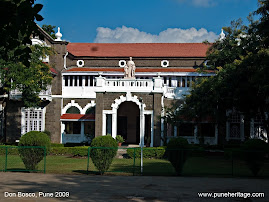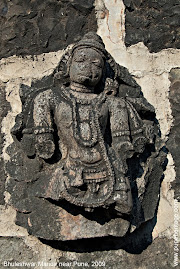Every Puneite has been here at least once. The true blue, hold it close to their hearts. Health enthusiasts flock here every morning and evening, devotees queue up for one glimpse of their God and artists derive inspiration from it. That’s Parvati for you.
Due to its geographically strategic position (2100ftabove sea level), proximity to a water source -Katraj lake and its location - on the old trade route connecting Dive Ghat – Kalyan-Nala Sopara, Parvati was the obvious choice of Shrimanta Nana Saheb Peshwa (son of Bajirao Peshwa - the First) for his abode. In fact, one evidence of Pune being an ancient city (8th century) is found here at the north-east end of Parvati. Do visit this cave; you will have to take small walk to locate this structure.
Legend has it that Peshwa Nana Saheb aka Balaji Bajirao’s mother - Rani Kashibai was suffering from a severe foot ailment. She went to a temple in the south of Pune which was famous for its miraculous healing power. Kashibai prayed for her recovery and vowed she would build a larger temple there if she got cured. Her wish was fulfilled and her son built a temple on the hill in the year 1749 A.D. This is the famous Parvati Temple.
At the tender age of 10, on 25th June 1740 Nana Saheb was sworn in as Peshwa by Chhatrapati Shahu Maharaj (Chhatrapati Shivaji Maharaj’s grandson). Within 10 years of his reign, he attained control over Maval, Bengal, Madhya Pradesh, Rajasthan and during the next decade over even Karnataka and Telangana. Nana Saheb Peshwa used to venerate Chhatrapati Shahu Maharaj, who had given all the administrative responsibilities to the Prime Ministers - Peshwas. One of many legends says that after the passage of Chhatrapati Shahu Maharaj, Nana Saheb took his Khadav (foot wear) along with him to Parvati and wanted to spend rest of his life with his memories (in ancient Hindu culture, disciples show the highest level of respect by worshipping the Khadav/Paduka of their Gurus).
Nana Saheb lost his cousin, Sadashivrao Bhau (the son of Chimaji Appa), and his eldest son, Vishwasrao, at the disastrous Third Battle of Panipat. He could not recover from the shock, and died soon after the debacle in 1761.
The residence of the Peshwas is built like a Land Fort (Bhuikot Killa) with very tall walls (Buruj) for defense. Do take a walk towards the western end of the hillock from where one can see part of this Buruj. A considerable part of the Peshwa residence is converted into a museum which displays artifacts, coins, paintings, kitchen items, musical instruments, entertainment artifacts, old furniture, masonry items, fighting gear and armor from the Maratha era. The Peshwa family and many Sardar families have donated these items to the museum. We were told that the wooden pillars and intricately carved windows (Meghdambari) are from the fort of Burhanpur (Indore district).
The residence of the Peshwas is built like a Land Fort (Bhuikot Killa) with very tall walls (Buruj) for defense. Do take a walk towards the western end of the hillock from where one can see part of this Buruj. A considerable part of the Peshwa residence is converted into a museum which displays artifacts, coins, paintings, kitchen items, musical instruments, entertainment artifacts, old furniture, masonry items, fighting gear and armor from the Maratha era. The Peshwa family and many Sardar families have donated these items to the museum. We were told that the wooden pillars and intricately carved windows (Meghdambari) are from the fort of Burhanpur (Indore district).
The main temple Devdeveshwar (Shiva-Parvati) is built as per the ‘Panchaytan’ style (idols of the deities of Shiva, Vishnu, Shakti, Ganapati and Surya are worshipped separately but in the same premises). Later additions by other Peshwas are the Vitthal, Vishnu and Karthikeyan temples, which are equally beautiful. One needs special permission from the Parvati Trust to photograph the idols of the Gods (it is mainly to protect the rare idols from theft). If permitted, we would make the pictures available to our readers soon. As usual nothing could stop us from photographing this magnificent Nandi!
The Devali style (5 domes - one main dome with four smaller replicas, one on each corner) evolved during the Peshwa regime. The mixture of Hindu and Muslim architecture is reflected through minarets, floral arches and lotus motifs. The enamel work is also of Muslim influence and was used in jewelry and Meghdambari carvings. Though this temple was built for the private use of the Peshwa family, it appears that religious and educational gatherings were held here regularly. Arrangements for the visitors were made in the temple premises; visitors would camp in the ‘Ovari/Gacchi’ (big niches along the walls).
We spent considerable time with the people who look after the administration and maintenance of the Parvati premises, they are a nice lot. Sure, maintaining such premises has its own challenges! Next time you visit Parvati, I suggest you go as a student, and a lot of history will come alive for you.




















Hi Vaishali,
ReplyDeleteVery Nice pics and article. If you permits, I would like to use some of the photographs for my website which non-profit informative site. Hope you're ok. if not never-mind. just let me know.
Tx.